Final Report/Thesis 2018
Abstract
The corpse of a mystery man’s body was found at Adelaide’s Somerton Beach, South Australia, Australia, on the 1st December 1948 and was hence referred to as the Somerton Man. Till this day the identity of the Somerton Man and the cause of his death is unknown. This project will be broken up into three different tasks, with all contributing towards the unsolved case of the mysterious man. The first task is based around the piece of paper that was found inside his trousers pocket. This piece of paper had five lines of capital letters, and is thought to be some kind of code or cipher. It was found that this mysterious code was a part of a poetry book, known as the ‘Rubaiyat of Omar Khayyam’. The letters on the mysterious code are thought to be first letters of words, based on previous year’s project groups. The location of his death is near Morphettville Racecourse, which leads to belief that the Somerton Man’s mysterious code are different horse names. However, using various statistical approaches, this was proven to be not true. The second part of this project involved, using a mass spectrometer to analyse different isotopic signatures of the samples. More specifically, the samples used were the shaft of the hair, obtained from various people, which were ablated by the laser, and effectively recorded the various elements. This will be compared with the Somerton Man’s hair, to identify specific elements present, as well as noting how long he was in Adelaide before his death. Different DNA samples, were analysed in the final task. Using software tools the samples were degraded, until the DNA became unidentifiable. It was found that degrading 50% or greater of the DNA sequences, makes the DNA unidentifiable.
Acknowledgements
Project supervisor Professor Derek Abbott, for the helpful and motivational advice, as well as the exceptional guidance, which was presented on each of the completed tasks. The University of Adelaide Microscopy Centre, for permitting the project team to use the mass spectrometer. Dr Sarah Gilbert for the assistance and suggestions whilst using the mass spectrometer. Also, thank you to all the volunteer who gave their hairs to use during the experiment. In addition, the project team would like to acknowledge all the software support from University of Adelaide, including Microsoft, Matlab as well as Iolite from the Microscopy centre.
Introduction
Motivation
During this project, a study was undertaken on an unsolved murder case. On December 1st, 1948, an unknown man was found deceased, on Somerton Beach in Adelaide [1]. From then on, he was labelled, ‘the Somerton Man’. There was no form of identification present on him, as well as little information surrounding his death. Therefore, the cause of his death is still unknown to this day [2]. Figure 1 shows the deceased man.

A piece of paper with the words “Tamám Shud” printed on it, was found rolled up inside his trousers pocket, which can be seen in Figure 2. This statement can be translated from Persian to either “it is ended” or “it is finished”. This piece of paper was found to be part of a poetry book, the ‘Rubaiyat of Omar Khayyam’ [3]. The theme of the book is that, one should live life to the full and have no regrets when it ends [4].
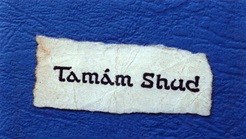
The book is speculated to be related to the dead man, due to the parchment. Hence, the case being known as the Tamam Shud case. This has been considered, since the early stages of the police investigation, to be "one of Australia's most profound mysteries [6].” Capital letters were found to be scribbled in the back cover of the Rubaiyat of Omar Khayyam, as seen in Figure 3. Thus, indicating that these letters are somewhat vital to the case at hand, as it is speculated that they may be a form of code or cipher.
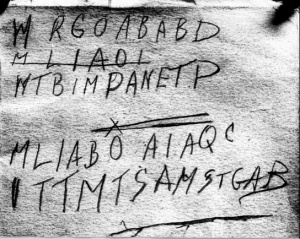
The code consisted of five various lines of capital letters, with a total of fifty letters all together. The second and fourth lines are very similar in the way in which they appear. It is therefore, believed that the Somerton Man may have made an error with the encryption, when writing the second line, hence why it is struck out. It is unclear whether some of the letters are in fact an “M” or “W” [7]. For tasks referring to the code, it is assumed that the unclear letter is an “M”. His body was found to be located near the Morphettville Racecourse, this leads to the belief, that the Somerton Man’s mysterious code are related to different horse names. It was also noted that the people who found the deceased body of the Somerton Man, were racehorse jockeys [2]. An Inductively Coupled Plasma Mass Spectrometer (ICP-MS) is used in this project to identify the various isotopes in various people’s hair. With the main concern of Strontium as, Adelaide has high levels in strontium in the soil compared to the rest of Australia.
Previous Studies/Related Work
Australian Department of Defence
In 1978, a request was sent by journalist Stuart Littlemore to the Department of Defence cryptographers to analyse the code. Unfortunately, the cryptographers were unable to crack the code, as they could not provide a satisfactory answer. It was stated that the code had “insufficient symbols” or a “disturbed mind” generated the meaningless code [8].
The University of Adelaide project groups
There have been several Honours project groups at the University of Adelaide that have undertaken this project. The previous work the project groups have done include:
- Letter frequency analysis in different languages.
- Initial letter and sentence letter probabilities.
- The likelihood of the code being an initialism of a poem.
- Different cypher techniques.
- The design and implementation of a web crawler.
- 3D generated reconstruction bust of the Somerton Man.
Main conclusions that these project groups have come to are:
- It is unlikely that the mysterious code is created randomly.
- There is strong evidence to believe the mysterious code is most likely to be in English.
- It is not likely that the mysterious code are initialisms extracted from poems.
- The Rubaiyat of Omar Khayyam was not used as a straight substitution one-time pad for encryption.
- The Rubaiyat of Omar Khayyam was not created as a one-time pad for the mysterious code.
With these conclusions, this project will look into further detail of what the Mysterious Code is [9] [10] [11] [12] [13] [14] [15].
Mass Spectrometer Pervious Work
Previous years have also done study with Mass Spectrometer. The 2013 project group had some of Somerton Mans hair and plotted the different elements in the hair comparing with controlled samples. Analysis was conducted on different elements between the two samples. This was done using a glass slide, which have impurities in it [13]. In the 2016 project group, they recreated the analysis using a quartz slide, which does not have impurities. They concluded that Somerton Mans had some abnormally high readings, of some elements, one of which is strontium [15]. In this project, the strontium level will be looked in higher detail and this will be used to indicate how long the Somerton Man was in Adelaide before his death.
Aims and Objectives
The first task that will be done is to understand if the mysterious code are a collective object (horse names, Adelaide street names, Australian beaches, etc.). This will be done using hypothesis testing. An extension of this task will also be completed, which involves the Rubaiyat of Omar Khayyam. The second task that will be performed is using a mass spectrometer. Controlled sample hairs will be compared with Somerton man’s hair, to see how long he was in Adelaide before his death, by finding different elements in the hair. The third task that will be accomplished is using DNA data. The data will be degraded using software tools till it becomes unidentifiable. This then can be used to see how much DNA we need from Somerton man, where further research can undergo.
Technical Background
P-value Theorem
A p-value is a recognised statistical probability, which acknowledges whether an equal or larger effect is present, in comparison to its observed counterpart. In statistics, the p-value helps you determine the significance of the statistical hypothesis by observing the results that were sampled. This determines the probability that the results are due to chance, rather than the experimental conditions. Thus, determining the strength and validity of the results against that of the null hypothesis [16]. In this project, the main focus with the p-values is to determine whether the mysterious code, represents local horse names. Where the null hypothesis is ‘The group of letters are horse names’ with the alternative hypothesis being ‘The group of letters are not horse names.’ For null hypothesis to be accepted the p-value must be larger than 0.05, this indicates that the observed data point is located in the ‘most likely observation’ range, as seen in Figure 4. If the p-value is lower than 0.05, this indicates that the collected results are statistically significant and that the observed data point is located in the ‘very unlikely observations’ range. If the results are in the ‘very unlikely observations’ range, then the null hypothesis can be rejected, which means that the mysterious code is indeed, not horse names [17].
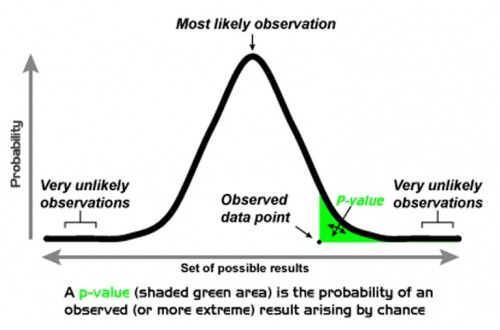
Figure 4: Computation of a p-value [18] Figure 4 shows, the y-axis is the probability and the x-axis is the set of possible results.
Mass Spectrometer
A mass spectrometer is an analytical technique which, when given a foreign sample, it can detect unknown compounds within it. The mass spectrometer produces a multitude of ions in the sample, which then uses a mass to charge ratio of the different ions and records the quantity of each ion type [19]. The components of a typical mass spectrometer is seen in Figure 5. The three major components are the ion source, analyser and the ion detector system.

The ion source produces gaseous ions from the sample that was used. The analyser, then sorts the different ions by using the mass-to-charge ratio, according to their mass components. The ion detector system detects the different ions in the sample and records the quantity of each ion type and converts it into an electric signal [20]. The Inductively Coupled Plasma Mass Spectrometer (ICP-MS) is the type of mass spectrometer that was used in this project. The ICP-MS is faster, more precise and sensitive at finding different ions compared to other types of mass spectrometer [21]. In regards to the project, the sample being used is the shaft of the hair.
Single Nucleotide Polymorphism (SNP)
Single Nucleotide Polymorphisms (SNPs), are one of the most common and well talked about genetic variations, which can be present between humans [22]. These variations occur within a nucleotide (a single block of DNA) and happen roughly within 1 out of 300 base pairings [23]. In regards to the project, SNPs will be removed from a DNA sample.
Task 1: Code Analysis
Aim
The aim of this task is to comprehend whether the mysterious code represents some collective object. The collective objects that will be used are horse names, Australian beaches and cities, South Australian street names, and The Rubaiyat of Omar Khayyam book. The assumption will be made that the letters in the mysterious code, are the initialism of a word. The Somerton Man had a lot of associations with horses, so further research will be going into the assumption that the mysterious code are ‘horse names’. The null hypothesis is ‘The group of letters are horse names’ and the alternative hypothesis is ‘The group of letters are not horse name.’
Preperation
Before the initialisation of this task, the details of the whole case were reviewed. This review included the following; who found the corpse, where it was located and when it was discovered. This gave a better understanding of what type of collective object should be researched, which are stated above. As mentioned before, the reason why horse names are a major factor is because the location of his body was found to be located near Morphettville Race course, as seen in Figure 6.
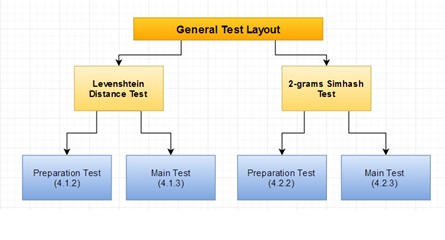
Figure 6: Location of Somerton Beach and Morphettville Racecourse [24] It should also be noted that the people who found the deceased body were racehorse jockeys. Hence the reason we assumed the mysterious code are the initialism of horse names from the year 1948.
There are mainly two aspects of tests in this project, the Direct Comparison Test and the 2-grams Comparison Test. Nine different languages are selected and tested, they are English, Italian, French, German, Portuguese, Latin, Spanish, Turkish and Polish. As this section may be too long and disturbing, here presents a simple chart for the navigation usage in Figure 6.

Levenshtein Distance Test
The comparison method of this section is calculating the Levenshtein Distance between two initialism strings directly. Materials used for comparison, length of string and comparison time may vary based on the purposes of setting up each test.
Data Processing
All the materials for this test were transformed into Initialisms format, with all punctuations and spaces removed, for example: Original Text: “Snow is falling, all around me, children playing, having fun…” Initialisms Format: “SIFARMCPHF…” Initialisms were then divided into segmentations of a given length. Each segmentation is referred as ‘unit’ in the next sections.
Preparation Test
It is always necessary to check if the method for tests is effective before starting any tests. Hence the purpose of this section is to prove that the Levenshtein distance algorithm has the ability to revealing the differences between different languages. Units of a fixed length extracted from English version and eight different language versions of the War and Peace were compared. To make it comprehensive, there are six groups of tests with different length varies from 50 letters/unit to 800 letters/unit and in each length group there are 100 times of comparison (10 units of one language compared with 10 units of another language one by one using a double ‘for loop’ ). Each unit was uniquely selected from texts without any overlapping. Results of these tests are normalized with the unit of length = 50.
The result of the tests was presented in boxplots in the figure below (Language names were abbreviated, En stands for English, It-Italian, Fr-French, Ge-German, Pq-Portuguese, La-Latin, Sp-Spanish, Tr-Turkish and Po-Polish). Each box is a set of the output Levenshtein Distances between two texts. For example, the leftmost box represents the test results of 10 English units versus another 10 English units; same rule applies for the others.
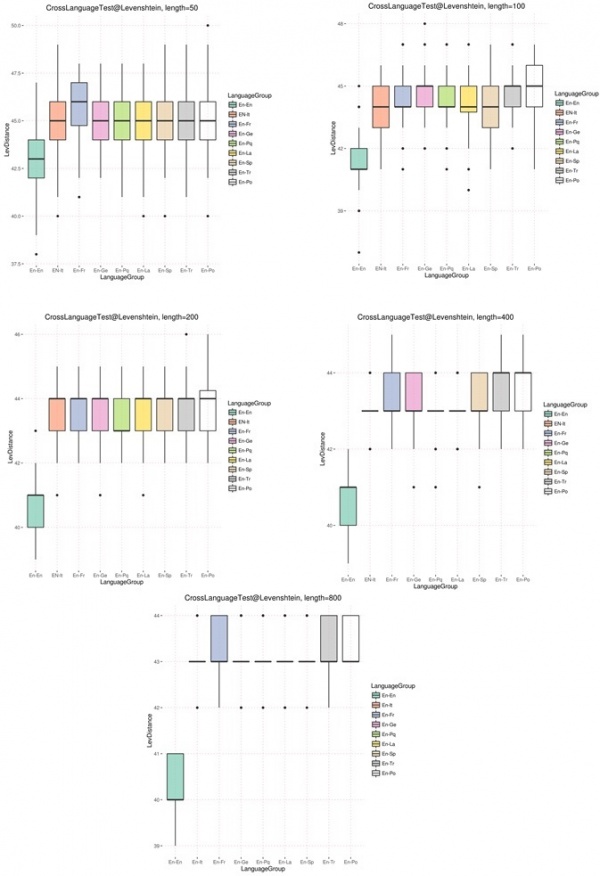
By analyzing the five box plots above in the Figure Group 1, the following conclusions can be inferred: 1. In all the five figures, the leftmost boxes are significantly lower than the others, which mean that the Levenshtein distances between English strings are much lower than those between English strings and strings of other languages. Hence, the Levenshtein Distance is able to manifest the difference between different languages.
2. As the unit length grows the boxes become lower and more compact (median value and standard deviation shrink when unit length goes up). Some of them even converged into a specific value. In addition, the difference between the last two plots (unit length = 400 and unit length = 800) is trivial. It means that the Levenshtein distances tend to be stable as the length of the unit increases.
3. When increasing the unit size, the trends of the nine language groups are highly similar: median values of the Levenshtein Distances decrease as the unit size increases. This implies that the performance of the Levenshtein Distance algorithm is independent with different languages.
Main Test
The previous section has proved that the Levenshtein Distance actually can reveal the differences between languages. Based on this, the test in this section is to find out the difference between the mysterious code and texts of varies language. In the experimental group (line plots in figures), two versions the mysterious code were compared with 100 units of different languages extracted from the War and Peace. As the code is only of 50 letters long, there is no need to carry out the test in different unit length. In the comparison group (box plots in figures), units extracted from the UDHR were compared with the same materials in the experimental group. Like the preparation test, this test was also divided into 6 different length groups. 100 times of comparison was made, the 10 vs 10 double for loop structure was also preserved here. The reason why Latin language was not tested is because that the Latin version of the War and Peace was not found, and lacking of material for the control group test would affect the confidence. Results are presented in the following figures. The horizontal line indicates the mean (average value) of the experimental group’s result and the boxes indicate results of the comparison group. For example, in the first plot: the six boxes represent the test result of UDHR units in English versus War and Peace units in English in six different length groups. Two lines indicate the test result of two versions of code versus units of War and Peace in English. The “Codes vs English” test results (red and green lines) appear in every plot as a reference.
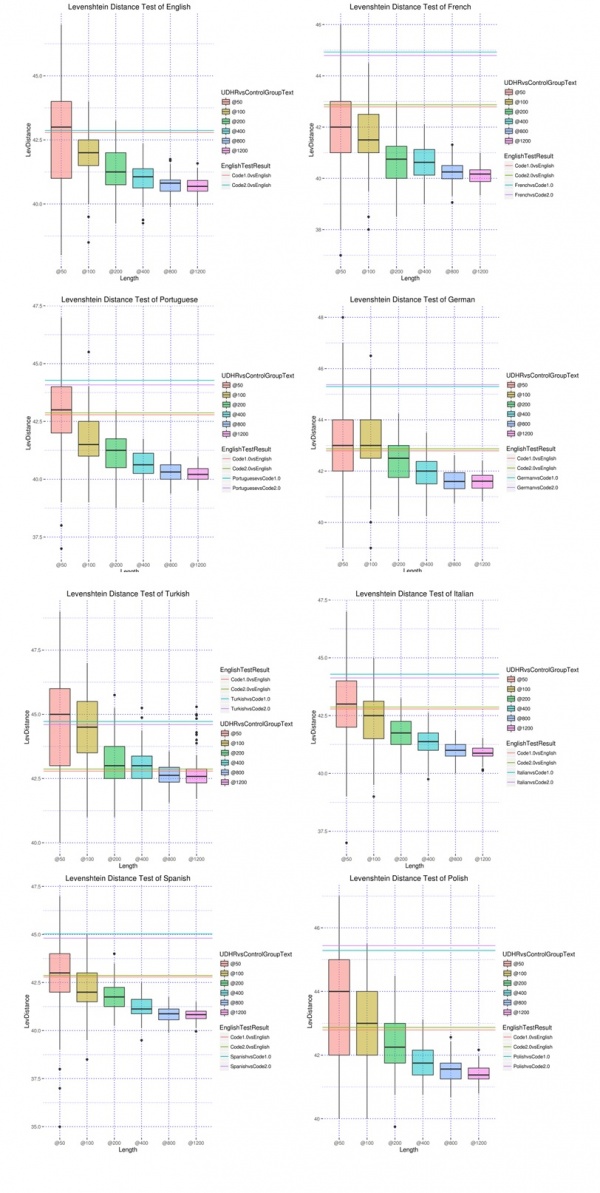
The following interesting phenomenon could be observed from the Figure group2 above:
1. Observing within each plot: both the median value and the standard deviation fall as the unit length increases. This trend fits reasonably well with the trend of the preparation test (the one mentioned in the 2nd conclusion of section 4.1.2). 2. Observing from the second plot to the last plot: there are distinct gaps between the Levenshtein Distances of codes versus English text (red and green lines), and the Levenshtein Distances of codes versus other languages (blue and purple lines). 3. Among all the languages tested except English and Turkish tests, results of the experimental group are consistently higher than results of the comparison group. In addition, experimental group’s result in Turkish was significant higher the one in English. 4. Observing inside of the English test plot and the Turkish test plot: both the two groups of lines located around the median value of test result in 50 letters length group. Conclusion:
According to the aforementioned phenomenon, the corresponding inferences can be drawn out: 1. The similarity of two trends reveals that the Levenshtein Distance algorithm does not sensitive to different testing materials. On the other hand, the relatively higher standard deviation in 50 letters group implies the higher randomness in small length tests. Notice that results of the experimental group are literally of 50-letters group. This reduces the credibility of the whole test. 2. Within the scope of the experimental group, the mysterious code has relatively smaller Levenshtein Distance with English text compared to those with other languages. 3. The differences between results of experimental and comparison groups in six languages (German, Italian, French, Portuguese, Spanish and Polish) imply that the code is unlikely to be one of these languages. 4. In English and Turkish test results, the overlapped results from experimental and comparison groups imply the consistencies of the Levenshtein Distances between ‘Code vs War and Peace’ and ‘UDHR vs War and Peace’.
Conclusion of the Levenshtein Distance Test
According to the previous analysis, the code has more possibility to be initialisms of English or Turkish text, rather than of texts in other languages. In addition, considering the higher Levenshtein Distance in “code vs Turkish” test, being initialisms of English is more possible than being initialisms of Turkish. On the other hand, the credibility of the test was challenged by the existence of randomness in small length group test. Hence the conclusion that the code is more likely to be English should be considered cautiously.
2-grams Simhash Test
Though the previous test has drawn out some useful conclusions, its lacking of credibility is still unacceptable. As a result, the 2-grams test with another algorithm (SimHash algorithm) has been designed and implemented. The test is expected to give supports to the conclusion drawn out in the previous Levenshtein Distance Test. In the meantime, it is expected to have a better credibility.
Data Processing
Another difference was that texts for this test were rearranged into the 2-grams format based on the initialisms format in the previous test. For example: Original String: “The visions dancing in my mind the early dawn the shades of time …” Initialisms format: “TVDIMMTEDTSOT ...” 2-grams format: “TV VD DI IM MM MT TE ED DT TS SO OT T…”
Preparation Test
Just like before, the preparation test was designed to check the performance of algorithm. Unlike the Levenshtein Algorithm, the grouping of test based on unit length is meaningless. This is because of the nature of the Simhash algorithm. For details please refer to section 3.2.2. The preparation test was based on the UDHR. In the first test: it compared 50 units extracted from the English version of UDHR with the whole text of UDHR (2-grams formatted as well) in both English and other languages, by firstly turning each unit to its corresponding Simhash string, then calculating the Hamming Distance between two Simhash strings. In the second test, the same method and layout are used again to compare 50 units with the whole text of UDHR in the same kind of language. To make it simple, test 1 is a cross-language test while test2 is a same-language test. Results were presented in the two box plots below (apologize for the being out of order of the x-axis; please make comparisons according to the column names under each box):
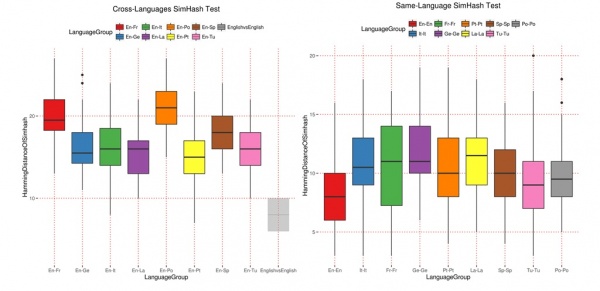
Comparing inside the cross-language group (Figure 20): the data set of “English versus English” (the more transparent box located at the bottom-right of the first figure) is considerably lower than other cross-language data sets (colored boxes in the first figure).
Comparing across the two figures (Figure 20 and 21): it is easy to find out that the cross-language group has generally higher results than the same-language group (Color schemes in two figures are not the same , please refer to the column names when doing comparison). Median values of boxes in same-language group are all significantly lower than those in the cross-language group. All third quartiles (Q3) in the same-language group are lower than first quartiles (Q3) of the corresponding language group in the cross-language group.
In addition, data sets in figures above are less biased compared to those in Levenshtein Test. Distributions of data in each boxplots are quite compact. The Simhash Algorithm is not sensitive to different languages. These facts give extra credibility to the Simhash algorithm. Based on the aforementioned observations, it is reasonable to draw out the conclusion that the Simhash Algorithm has an excellent ability of distinguishing different kinds of languages.
Main Test
Here, the two versions of the mysterious code are tested against the UDHR in different languages. For each version of code, it was compared to different language versions of the UDHR. Results are presented in the first bar chart. Pink represents the first version of the code and blue represents the other one. (Each bar actually consists of two sub-bars, length of sub-bar represents each result, and there is no overlapping between sub-bars). As there is little difference between pink and blue bars, the average value in each language group is taken. For comparison purpose, these average values are combined with the same-language test result, and presented in the second figure below (bars in the left figure are turned to horizontal lines in the right figure, which represent the mean value of the Hamming Distance set between code and a specific language):
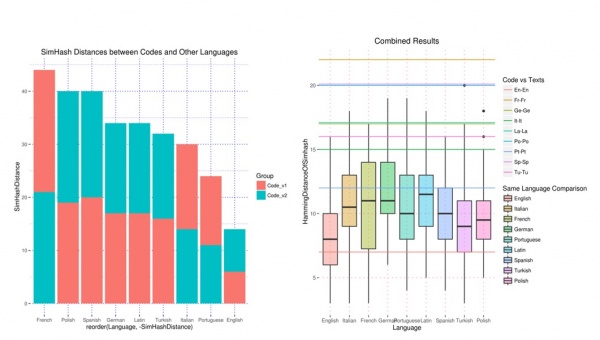
Considering that the comparison between two versions of code and the UDHR texts may not be sufficient to draw out any convincing conclusion, the two versions of code are compared again with 12000 letters long War and Peace text in each language using the same Simhash method. As the two versions of code have extremely similar test results against a specific language, the two versions’ results are added together in each language group. Result of the test is shown below:
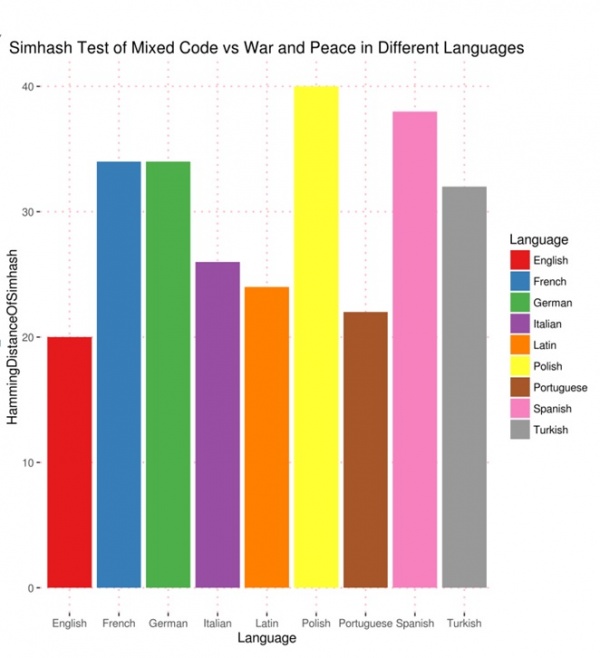
Figure 22 clearly showed that the Hamming Distance between English and the code is the minimum; figure 24 also presents the same characteristic. In Figure 23, there are two horizontal lines reside inside of their corresponding boxes: English and Portuguese. But compared with Portuguese, the red line that represents the result of code vs English is relatively closer to the median value of the English vs English test result set.
Conclusion of the Simhash Test
Based on these facts, the conclusion is that the mysterious code is more likely to be English, rather than other eight languages being tested.
Summary of Tests
In Section 4, there are generally two groups of tests presented: the Levenshtein Test and the 2-grams Simhash Test. The Levenshtein Test has given the opinion that the mysterious code is more likely to be English initialisms; but its credibility was challenged by the randomness appeared in the 50-length group test. On the other hand, the opinion inferred from the Levenshtein Test has gained vigorous support by the result in the 2-grams Simhash Test. For the secondary suspected languages which are Turkish and Portuguese respectfully in two tests. By comparing results of two tests together the suspicion can be removed. As the Turkish test result in the 2-grams Simhash test was not as conspicuously high as the one in the Levenshtein Test, nor did the Portuguese test in the Levenshtein test perform abnormally. Now, there are enough evidences to support the final conclusion that the code consists of Initialism of English.
Task 2 Mass Spectrometer isotope Data Analysis
Relative research
1.Hair elements Hair analysis can demonstrate the content level of the heavy mental and essential elements in human body. [19] The different value of some essential elements in hair may be correlated with nutritional status and diseases, such as calcium (Ca), chromium (Cr), zinc (Zn), copper (Cu), and selenium (Se). The high values of some elements such as lead (Pb), arsenic (As), mercury (Hg), and cadmium (Cd) in hair can indicate the intoxicating phenomenon. [19] Using this analysis method can discover the useful information about the Somerton man healthy condition and has possibility to find the cause of death. 2.The relation between living environment and hair elements The living environment can affect the content level of elements in human body. This effect not only caused by polluted water and food, but through the injury and radiation. Trace elements values in hair can reflect the source of behaviors including the diet hobbies, smoking and medication. Human absorbs pollution source by different ways such as oral, breath, injection and radiation. These contaminants stored in different body organs and tissues can affect human health. Hair is a good indicator of environment change. Normally, it shows the variation of trace element in human body as the hair growth.
Glass test data analysis
Data screening
The hair data was recorded by mass spectrometer and the data was got from glass test. There are 44 elements gained by laser ablation (shown in Table 1). Three of these elements are needed to be mentioned. The first one is sulphur (S7) which must exist in human’s hair. The value of Sulfer can be refered to the drift value of the environment. The second one is lead (Pb206), the high level of Lead is harmful for human health. The third one is strontium (Sr88). This element has high percentage in Adelaide’s soil compared with other areas. So, the analysis of the change tendency of Strontium’s value will provide useful information about Somerton man’s living environment before his death. Table 1 Elements table for glass test
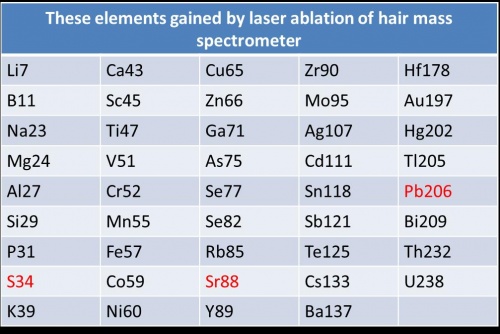
Element classification
Some recorded hair data contains toxic and heavy mental elements which are harmful for human health in high values. However, most are essential elements for human body. Table 2 shows the toxic elements and essential elements in hair. The comparison of toxic elements content in hair is an important research subject.[21] Table 2 the Different Type Elements of Hair

In previous study, the hair data analysis is based on glass test result. However, the impurity material has influence on element values, thus, the data analysis mainly relies on quartz test rather than glass test in this project. Compared with glass plate, the quartz plate is a purity material composition. Table 3 shows the main composition of glass and quartz. Table 3 The different Elements of Glass and Quartz

Element content comparison
In order to speculate the cause of death and living environment, the Somerton man hair data should be compared with control samples. In this experiment, six normal people’s hairs are selected as control samples. Then, the mass hair data is disposed by software for a visual comparison. Excel At first, the hair data of Somerton man was plotted by Excel (shown in Figure 6). The X axis demonstrates the scan time of mass spectrometer. The Y axis demonstrates the relative value of elements content. Figure 1 Somerton man’s hair data
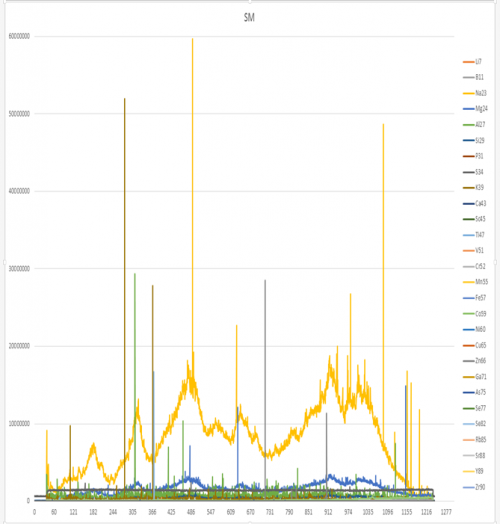
However, only 28 elements were shown on the chart. Some data was missing due to the shortage of Excel. Besides, most elements are not clear except sodium (Na23). Some traces are out of range and not obvious, such as the elements located on the bottom of this chart. So, these troubles result in the difficulties of contrast. The control samples hair data plotted by Excel (shown on appendix A) as well. Unfortunately, they all have the shortages as the Somerton man’s data chart. Matlab In order to solve these problems, Matlab can be used to plot each element’s content distribution. 44 elements comparison figures have been plotted and shown on appendix A. Some comparison figures of element value display the results clearly. However, some figures have difficulties to find the tendency. The elements figures’ classification is shown on table 4. Table 4 Classify elements by comparison results
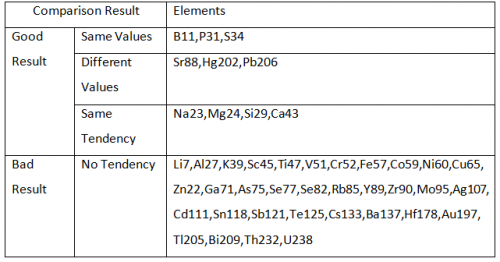
The quality of the results is considered below, four elements (Na23, Mg24, Si29 and Ca43) have the similar tendency. Meanwhile these four elements are all contained in glass material in previous study. This phenomenon can assume that the recorded elements values are affected by glass slice. However, the elements which do not exist in the glass will not be affected. In table 4, the same value means that the content of elements in the Somerton man and control samples can be regarded as the same value. Different value represents a significant difference in element content, and the change trend is not similar. No tendency means that the comparison figures can’t show the law of change and the results can’t be compared. Figure 7 shows the lead (Pb206) relative value comparison between Somerton man and control samples. Figure 7 Lead (Pb206) Value Comparison
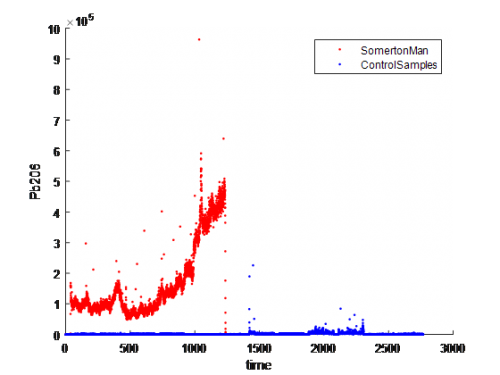
The X axis demonstrates the scan time of mass spectrometer. The Y axis demonstrates the relative value of Lead content. The mass spectrometer scans from the root of hair. Therefore, the smaller number of X axis represents the closer to death time. In Figure 2, the content of lead in control samples is very low and there is slight upward trend only in a short period of time. However, there have found a very high level of Lead in Somerton man’s hair compared with control samples especially the end of his hair. This situation of high lead content is worthy of attention. Through further studying the distribution graph of lead content, it clearly shows a tendency that the lead value has a visual reduction before his death. So, it can be affirmed that high level of lead was not the main cause of his death. In fact, the high level of lead content can be related to the living environment and the rapid decline in lead content may represents the recent replacement of the living environment. Thus, some of the geographic information in 1948 needed to research, such as solid analysis, petroleum quality, water quality and nuclear power plant location. Figure 8 shows the mercury (Hg202) relative value comparing between Somerton man and control samples. Figure 8 Mercury (Hg202) Value Comparison
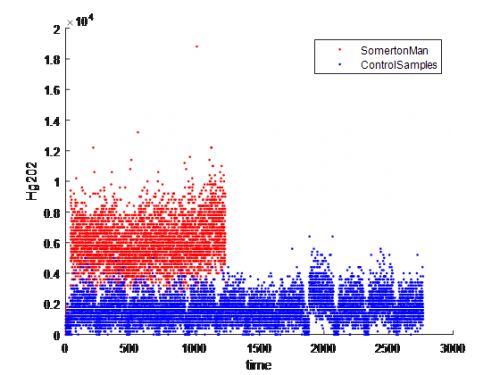
The X axis demonstrates the scan time of mass spectrometer. The Y axis demonstrates the relative value of mercury content. There have found a higher level of mercury in Somerton man’s hair compared with control samples. This value from root to the end of hair is basically the same. Through research, mercury is a highly toxic heavy metal pollutants of biologic toxicity. It is difficult to be discharged back into the organism. So it is a serious threat to human health. However, mercury is ubiquitous in nature. There are trace amounts of mercury existing in plants animals and food. Normally, human can eliminate toxins through excretion and metabolism to keep the amount that should not influence health. This is the reason for finding mercury in human’s hair. The main pollution of mercury is from chlor-alkali, plastics, batteries, electronics and other industrial emissions. The Somerton man’s higher level of mercury may be due to his living area. Thus, this should not be regarded as the cause of his death. The strontium value between the Somerton man and control samples’ hair are obviously different. Figure 4 shows the strontium (Sr88) relative value comparing between Somerton man and control samples. Figure 9 Strontium (Sr88) Value Comparison
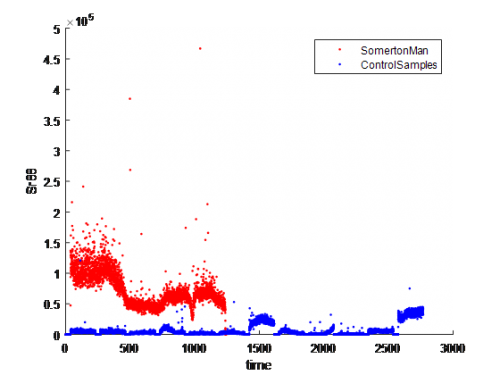
The X axis demonstrates the scan time of mass spectrometer. The Y axis demonstrates the relative value of strontium content. Strontium exists in mineral water. It is an essential element for human. This element can prevent hardening of the arteries. At the root of Somerton man hair, the content of strontium is significant high. This means the living area for Somerton man contains high level of strontium content before his death. In addition, the strontium value shows an increasing tendency in his last two weeks. However, strontium is not a toxic element and the increasing tendency is not the cause for the death of Somerton man. Reasonable inference is that the Somerton man changes living environment two weeks before the death and this is the same with the speculation for lead content change. Moving-average Filter in Matlab Some comparison figures cannot be shown clearly by Matlab plotting. Thus, the Moving-average Filter should be applied. Firstly, selecting a window size for Filter. Then, calculating the arithmetic average of outliers within the window and make the average of the demand as outlier’s window centre point. After that, moving the window as window size and the average method is repeated until this process is complete. This method has a good inhibitory effect on periodic disturbance and makes the figure smoother. It is suitable for high frequency oscillation system. All of the elements content figures have been plotted by using moving-average filter and shown on appendix B. After using moving-average filter, the comparison figures have some new founds, such that more similar tendency elements are found and some clear comparison figures have been shown. The details are shown on table 5. Table 5 Classify elements by comparison results
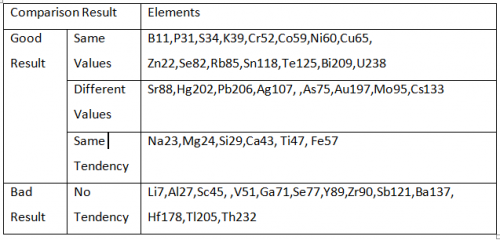
Through filtering, As75, Ag107, Cd111 are the new found toxic elements which have high level in the Somerton man’s hair. The content distribution is shown as follow: Figure 10 Cadmium (Cd111) Value Comparison
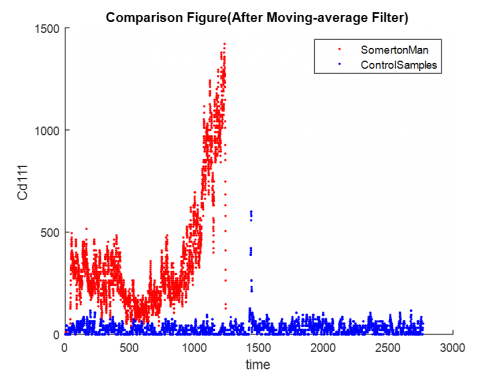
Cadmium is an element present in the nickel-cadmium battery and it is a toxic element which can create poison gas when boiled. The average content value of cadmium in Somerton man is much higher than control samples especially when the scan time is 1400 seconds. However, the change trend of this element are similar with lead and content value of cadmium shows a decreasing tend for his last time. Unlike lead, cadmium is more toxic and it can be regarded as the clue for the death of Somerton man. However, this kind of battery did not appear before 60 years. That can be indicate this battery is not the source of cadmium. It can also be observed from the figure that the hair for control samples contain cadmium as well. Thus, it can assume that this kind of element may come from drinking water or food, or other frequently used items. Figure 11 Silver (Ag107) Value Comparison
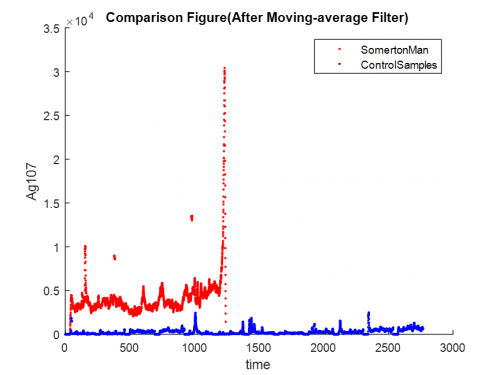
Through the observation of Figure 6,the silver content of Somerton man is higher than control samples. Besides, the value change for silver in hair of Somerton man is not obvious and the whole tends to be stable. Thus, this element should not be used for the speculation of Somerton man living condition. Besides, the element of silver is not harmful for human healthy. It can only make some colour change for skin. Thus, this element will not be researched in this project. Figure12 Arsenic (As75) Value Comparison
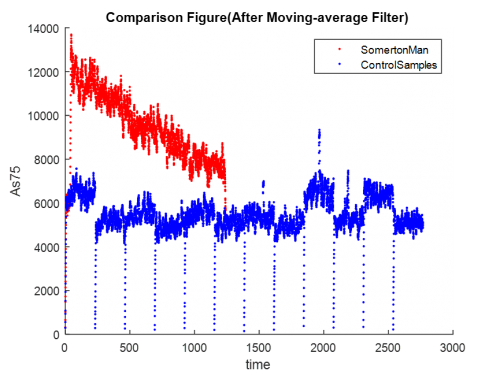
Arsenic content level in Somerton man is increasing during the last two week. At the tip of Somerton hair, the arsenic content is similar with control samples. That means this content level is not harmful for human. Besides, the living area of Somerton can be assumed as same as control samples. However, the arsenic level is significant high at his last few days and the arsenic can be used for making toxicant. So, changing living area or being poisoned should be considered. This comparison figure can be regarded as one valuable clue.
Quartz test data analysis
Data screening
Compared with glass plate, quartz plate is more pure. So, some elements recorded in the glass experiment were not present in the quartz test and some elements have different relative atomic weight. The recorded 35 elements in quartz test are shown in Table 6.
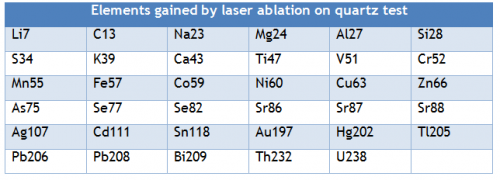
Data comparison figures
All of the quartz data is recorded. In order to comparison, the data of element has been classified as four sets of data: • Control sample hairs: Files name are Hair02-Hair08. For control hairs, it analyzed 2 sections of each hair, each 500um in length, so there are 0.7 centimeters control sample in total. The number of samples is seven, and each person takes two hairs as the two samples. • Somerton Man: It analyzed 500um sections, each subsequent transect beginning where the previous finished for a total of 96 sections (4.8cm total). • Standards: The files named NIST612-1 to NIST612-20 (20 transects) are standards and were run to ensure that the instrument wasn’t grifting too much during the analysis, they can be used to compensate for the drift if need be as they were run at intervals during the sample acquisition. • Background: Transits of 100um lengths across the quartz, files are Glue -1 to Glue–4. For the quartz test data, each element needs to plot three comparison figures. The first comparison is the comparison of four sets of data which are control samples, Somerthon man, quartz and standards. The second one is enlarged graph for the first comparison figure. The third figure shown fourteen control samples’ hair data comparison. Using the different colour dots to represent the four sets of data. Blue dots represent control samples, red dots represent Somerton man, yellow dots represent standards and green dots represent quartz background. The Figures (13-19) show the comparison of four sets of data. The X axis for all of the figures describes the scan times of the laser. The Y axis represents the relative value of elements in four sets of data.
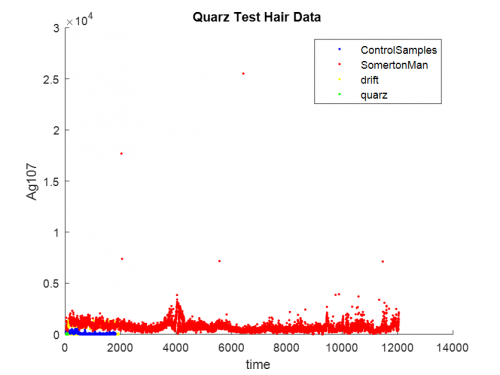
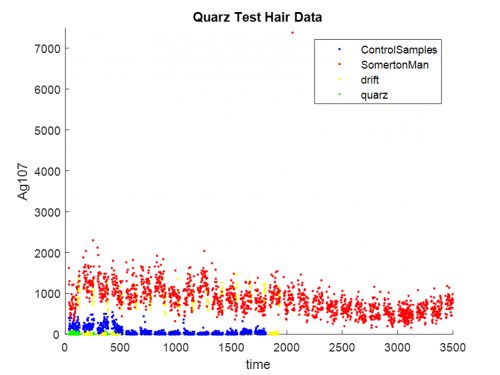
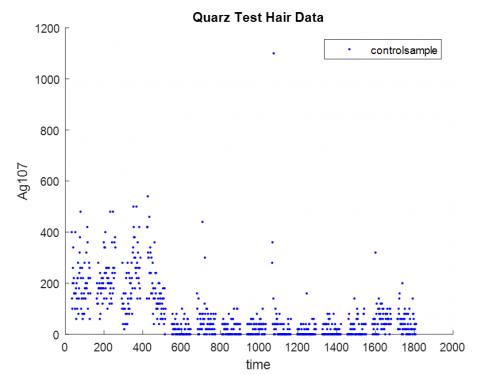
The comparison result of silver (Ag107) value between four sets of data is shown in Figure 8. Yellow dots represent the drift values which are basically stable and indicate that the drift change is not significant. Thus, the recorded data is reliable. Green dots represent the silver content in quartz. As can be seen from the figure, the content of silver in the quartz is very small. Therefore, this set of data has little effect on the test data. In general, the silver element content in Somerton man’s hair is higher than the control hairs. In quartz experiment, the relative content value of silver in the hair is a table value and it is similar with the glass experiment result. Figure 14 Carbon (C13)
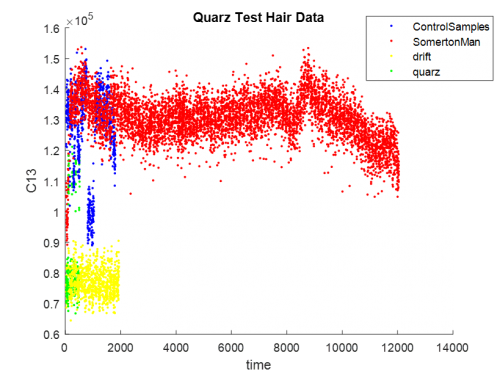
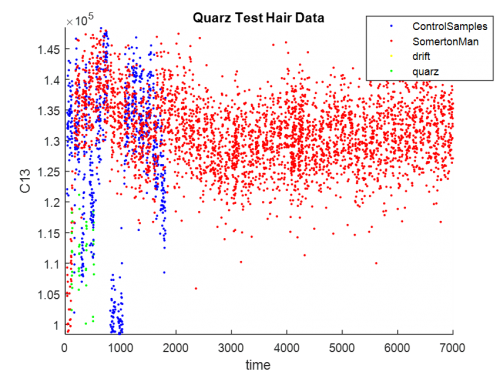
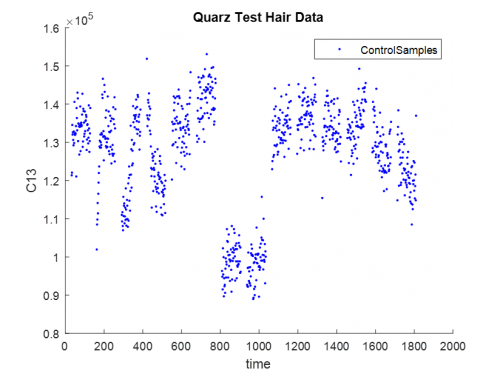
Figure 15 Sulphur (S34)
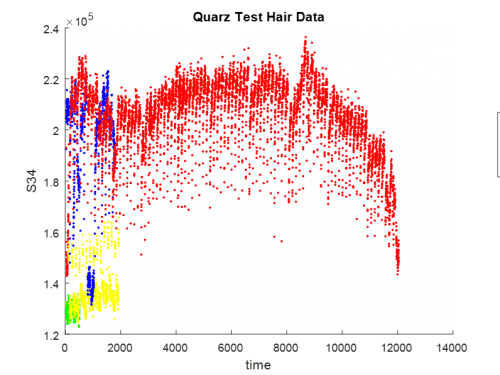
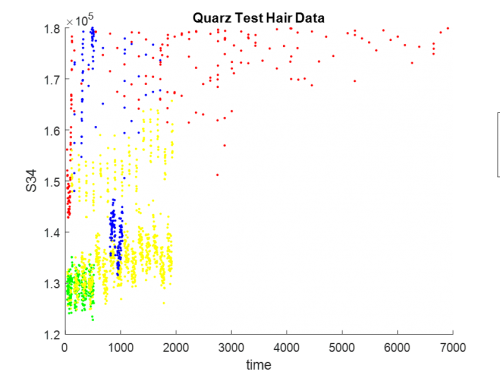
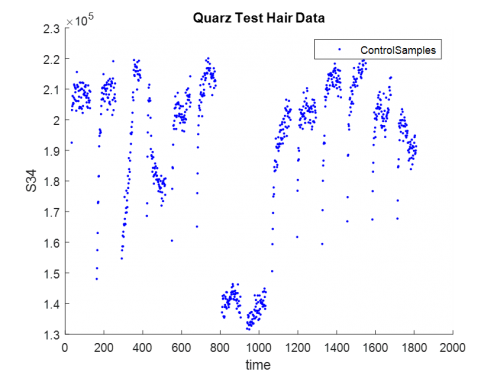
Same as silver, the standard values for sulphur and carbon are constant which means the instrument wasn’t drifting too much. By comparison, the carbon and sulphur relative values are similar among Somerton man and 12 control hairs. Only two samples have significant differences and these samples come from one special person. Carbon and sulphur are essential elements in human hair. The change in the content of these two elements can be a direct indicator of a person's living environment. Based on the comparison results of the Figure 9 and 10, the living environment conditions for Somerton man and six control samples are similar but different from the special one. Thus, the living environment of Somerton man can be confirmed. Figure 16 Calcium (Ca43)

Figure 17 Potassium (K39)

Figure 18 Strontium (Sr88)

Compared with the elements relative values between Somerton man and control samples, Figure 11, 12, and 13 have some similarities. The relative values of calcium, potassium and strontium in Somerton man’ hair are higher than most control hairs. However, the content of these three elements in two samples is close to the content of Somerton man’ hair. Moreover, these two hair samples both are from the one person. Based this result, it can be speculated that the content values of these three elements in the living environment for Somerton man and this special sample are similar. Figure 19 Lead (Pb206)
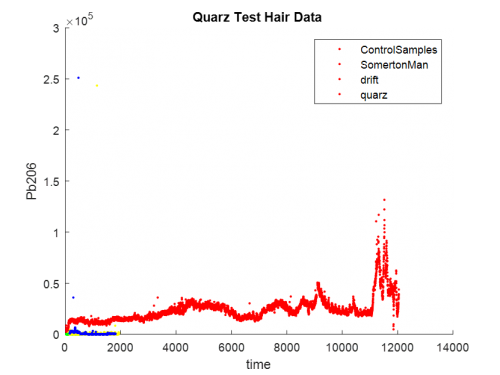
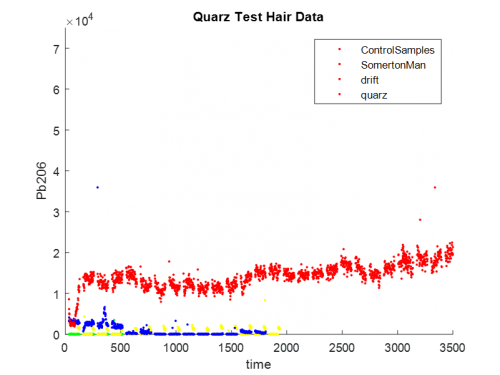
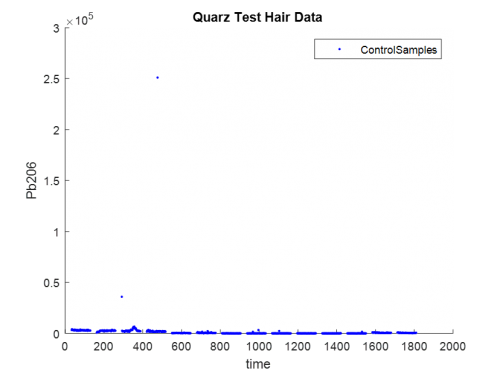
It has mentioned in the previous chapter that lead is a toxic element, and the data obtained from the glass plate experiment show that the lead content in Somerton man’s hair is significantly higher than that in control hairs. This phenomenon still exists in the quartz plate test. Since the incomplete hair for quartz plate test, the trend of lead content value in the hair before Somerton man dying cannot be expressed. However, the content of lead in Somerton man’s hair is indeed higher than the control hairs. The difference in lead levels does not indicate that the death of Somerton man is caused by the high level of lead in the body. The difference may be due to the fact that the lead content in human living environment is different from 60 years ago. Figure 20 Comparison of the relative values of some elements in control hairs
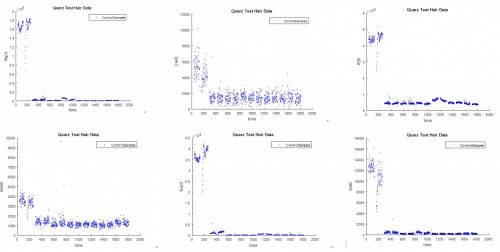

For control hairs, two sections of each hair have been analysed. There are fourteen control hairs which are from seven persons. By comparing these 14 samples, it was found that there was a difference in the elemental content between the samples, especially the first control person’s hair. Figure 15 shows the relative value of the first sample is significantly higher than the other samples. These elements are Mg, Ca, K, Mn, Na, Li, Sr. In addition, by the analysis and comparison results of several previous graphs, the values of the elemental contents of this sample are similar to those of Somerton man. From this result it can be inferred that this control sample and Somerton man have similarities in the living environment or lifestyles.
Two data comparison
Two tests data comparison table
In the glass plate test and the quartz plate test, 31 same elements were recorded and shown in table 7. Table 7 the Same Elements in Two Data Sets
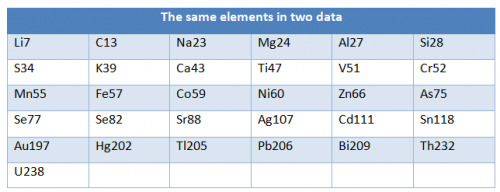
Comparison of Somerton man’s two hairs
In the last two chapters, we compare and analyze the differences between Somerton man and the control samples in the two experimental data. Next, the two experimental results of Somerton man's two hair data will be compared. We hope to compare the two groups of experimental data to find a same trend but different values data, and then multiply a constant number with one of the test data to obtain the other test data. Figure 21 (a) Silicon (Si) value comparison in quartz test
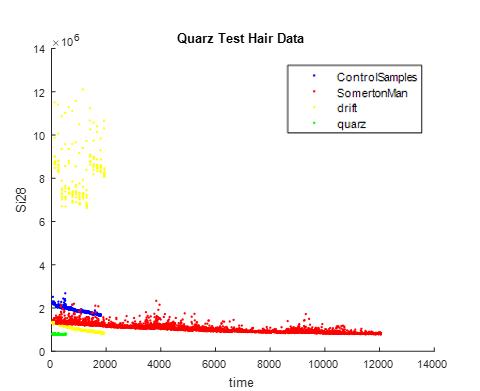
Figure 21 (b) Comparison of the relative values of Silicon (Si) in Somerton man hair
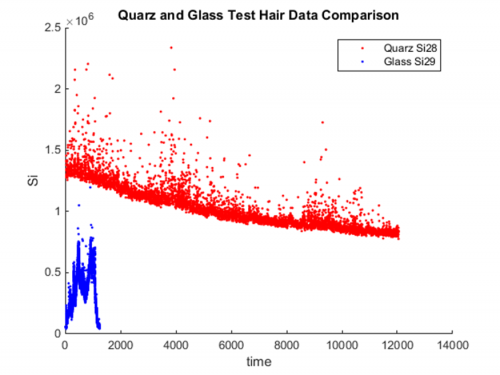
Figure 16(a) is a comparison of the silicon data obtained in a quartz plate experiment. The silicon content in the standard is reduced. So that the silicon content in the hair data is reduced. It is shown that the environment of test has influence on test result. From Figure 21 (b), these two hairs of Somerton man have significant different in the relative value of silicon. Besides, the trend of these two sets of data is significantly different. Thus, it cannot find the constant number from Figure 21. The following figures that from Figure 22 to 25 are the different elements comparison results of two Somerton man’s hairs. It is hard to find the same trend from this comparison. Therefore, it is necessary to find another suitable way to compare the two sets of data. Figure 22 Comparison of the relative values of Arsenic (As75) in Somerton man hair
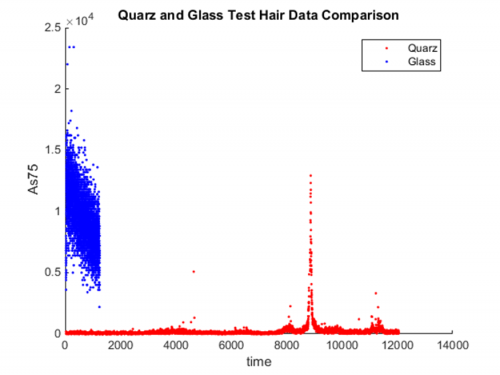
Figure 23 Comparison of the relative values of Strontium (Sr88) in Somerton man hair
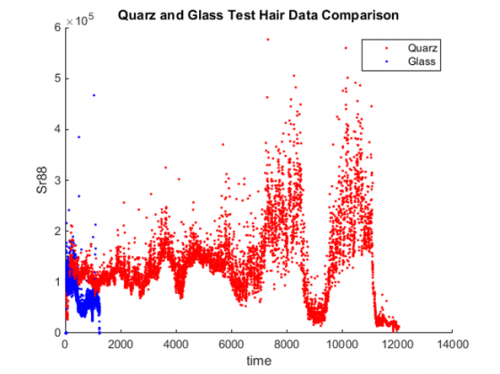
Figure 24 Comparison of the relative values of Lead (Pb206) in Somerton man hair
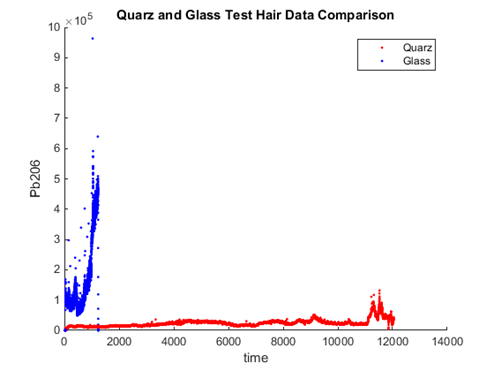
Figure 25 Comparison of the relative values of Sulphur (S34) in Somerton man hair
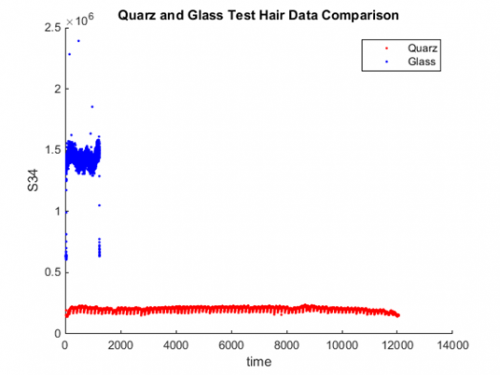
Project Management - Planning and Feasibility
Timeline
The timeline Gantt chart has been attached in appendix B. It has listed the key milestones of the project (shown in Table 7). Table 7 Key Milestones of the Project
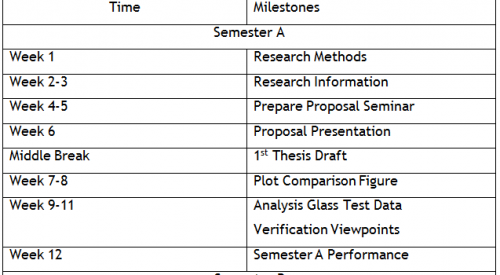
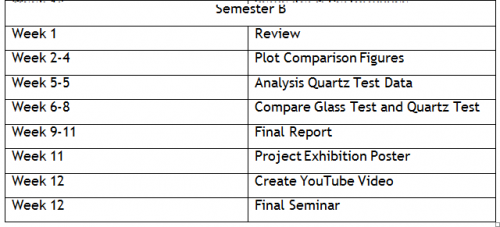
Work breakdown
The key task for the project is plotting and comparing data figures. Then, finding clues from the comparison. Due to two group members have different study directions, the project work is individual.
Task allocation
The project has two directions. In general, two group members worked on different tasks. This report devotes to analyzing the mass spectrometer data of the Somerton man hairs. The other group member works on cracking code and writing software
Management Strategy
To ensure finishing project on time, the following strategies have been applied: • Meeting with supervisors regualrly. • Receiving effective feed backs from supervisors • Finishing tasks without delay • Communicating with group member frequently.
Budget
No hardware was required in this project. All the softwares used in this project were either provided the University of Adelaide or open-sourced. As a result the $500 budget was not used at all.
Risk Management
The risks of project are listed in Table 2. The first risk should be considered is misunderstanding project tasks. So, the well communication with supervisors is essential. For this report, the crucial task is plotting figures by Matlab. Matlab unavailable will have influence on project processing. However, the Matlab is available on the computers of university. So, this risk can be negligible. Table 8 Project Risks
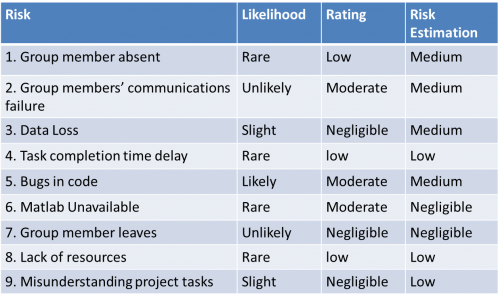
Future work
Code cracking
In the part of code cracking, the next several tasks are expected to be finished: 1. Extend the two tests to other languages which have not been tested. 2. Perform more n-grams test using the Simhash Algorithm. 3. Increase the number of tests in the 50-letters group Levenshtein test to see if the randomness can be avoided.
Hair data analysis
In the part of mass spectral analysis, Somerton man’s hair elements data which got from glass test and quartz test have been plotted. The future works as following: 1. Re-analysing the uncommon elements value of Somerton man’s hair 2. Find the Somerton man’s living environment clues 3. Find the same trend part from two Somerton man’s hair comparison figures. 4. Gain the constant number to multiply one test data
Conclusions
Code cracking
In this project, two new algorithms have been researched and introduced to check the similarities between the mysterious code and texts of different languages. Algorithms have been implemented in Java. Text materials for each test have been gathered and arranged into ideal formats. Individual test for each algorithm has been designed and implemented. After analyzing test results the conclusion that the code consists of Initialism of English has been drawn out.
Hair data analysis
In this project, three important comparisons of experimental data were made. These three comparisons are related to glass test, quartz test and the comparison of glass and quartz test results. In the comparison of the experimental data of glass plate test, the relative values of element content for lead, mercury, arsenic and cadmium in Somerton man’s hair are significantly higher than control samples in certain period of time. However, these elements’ content have been reduced to a safe range before his death. Thus the high content of these elements cannot be regarded as the main cause of Somerton man’s death, only as a reference to the change of living environment. In the comparison for the data of quartz test, the total amount of recorded elements were reduced from 44 in glass test to 35 which is due to the high purity of quartz plate. Thus, some elements in glass test are excluded. Through comparison, the content of carbon and sulphur in Somerton man’s hair has a large difference with the fourth sample. In addition, the content of potassium, strontium and calcium are similar with the first sample. Therefore, it can assume that Somerton man’s living area is different with the fourth sample, but similar with the first sample. The data comparison between glass and quartz test does not achieve the desired results. So, the experimental method may need to change in the future work.
Appendices
- Appendix A:Glass test figures
- Appendix B: After Moving-average Filters figures
- Appendix C: Quartz data figures
- Appendix D: Two test comparison figures
- Appendix E: The Timeline Gantt Chart
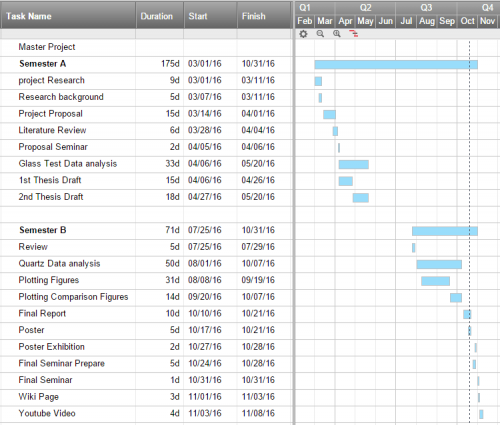
References
[1]. L. Griffith and P. Varsos. (2013). Semester B Final Report 2013 – Cipher Cracking . Available: http://www.adelaidenow.com.au/news/south-australia/somerton-man-mystery-new-details-revealed-of-jo-thomson-nurse-in-the-case/news-story/4c6bccbd2318584ad0cc6daaf3d8abd4
[2]. Renato Castello, “New twist in Somerton Man mystery as fresh claims emerge,” Sunday Mail SA, November 23th, 2013. Access via Internet: http://www.adelaidenow.com.au/news/south-australia/new-twist-in-somerton-man-mystery-as-fresh-claims-emerge/story-fni6uo1m-1226766905157
[3]. Lynton Grace, “Somerton Man mystery: New details revealed of Jo Thomson, nurse in the case”, The Advertiser, 29th May 2015. Access via Internet: http://www.adelaidenow.com.au/news/south-australia/somerton-man-mystery-new-details-revealed-of-jo-thomson-nurse-in-the-case/news-story/4c6bccbd2318584ad0cc6daaf3d8abd4
[4]. From Wikipedia, the Taman Shud Case. Access via Internet: https://en.wikipedia.org/wiki/Tamam_Shud_case
[5]. From Internet: http://ciphermysteries.com/wp-content/uploads/sites/6/2014/01/SomertonManCode-wikipedia.jpg
[6]. Inside Story, presented by Stuart Littlemore, ABC TV, screened at 8 pm, Thursday, August 24th, 1978.
[7]. A. Turnbull and D. Bihari. (2009). Final Report 2009: Who killed the Somerton man? Available: https://www.eleceng.adelaide.edu.au/personal/dabbott/wiki/index.php/Final_report_2009:_Who_killed_the_Somerton_man%3F
[8]. K. Ramirez and L-V. Michael. (2010). Final Report 2010 . Available: https://www.eleceng.adelaide.edu.au/personal/dabbott/wiki/index.php/Final_Report_2010
[9]. S. Maxwell and P. Johnson. (2011). Final Report 2011 . Available: https://www.eleceng.adelaide.edu.au/personal/dabbott/wiki/index.php/Final_Report_2011
[10]. A. Duffy and T. Stratfold. (2012). Final Report 2012 . Available: https://www.eleceng.adelaide.edu.au/personal/dabbott/wiki/index.php/Final_Report_2012
[11]. L. Griffith and P. Varsos. (2013). Semester B Final Report 2013 – Cipher Cracking . Available: https://www.eleceng.adelaide.edu.au/personal/dabbott/wiki/index.php/Semester_B_Final_Report_2013_-_Cipher_cracking
[12]. N. Gencarelli and J-K. Yang. (2015). Semester B Final Report 2015 – Cipher Cracking . Available: https://www.eleceng.adelaide.edu.au/personal/dabbott/wiki/index.php/Final_Report/Thesis_2015
[13]. MS. Charikar. (2002). Similarity estimation techniques from rounding algorithms. Available: https://www.cs.princeton.edu/courses/archive/spr04/cos598B/bib/CharikarEstim.pdf
[14]. G.S. Manku, A. Jain and A. Das Sarma. (2007). Detecting Near-Duplicates for Web Crawling. Conference on World Wide Web. http://citeseerx.ist.psu.edu/viewdoc/download?doi=10.1.1.78.7794&rep=rep1&type=pdf
[15]. From Wikipedia, the Vector Space Model. Access via Internet: https://en.wikipedia.org/wiki/Vector_space_model#/media/File:Vector_space_model.jpg
[16]. From Internet: http://static.oschina.net/uploads/img/201308/30125158_L1CI.jpg
[17] Adelaide Microscopy, ‘instrumentation’ viewed on 23 March 2016 <https://www.adelaide.edu.au/microscopy/instrumentation/icpms.html>
[18] ‘Australia can solve one of the world’s most intriguing mysteries by exhuming the body of The Somerton Man’ 2015, in NEWS.com.au, viewed on 15 March 2016. <http://www.news.com.au/national/crime/ >
[19]Batool,AI, Rehman, FU, Naveed, NH, Shaheen,A and Irfan,S 2010 ‘Hairs as biomonitors of hazardous metals present in a work environment’ in Full Length Research Paper, vol. 10, no. 18, pp.3602-3607.
[20] ‘Dead Man Found Lying on Somerton Beach’ 1948, in The News, vol. 51, no. 7902, pp. 1.
[21] Miekeley, N, Dias Carneiro, MTW, and Porto da Silveira, CL 1998, ‘How reliable are human hair reference intervals for trance element?’ in the Science of the Total Environment, vol. 218, no. 1998, pp. 9-17.
[22] School of Electrical and Electronic Engineering ‘Final Year Project Proposal’, 2014
[23] ‘Somerton man’ viewed on 23 March 2016 <https://en.wikipedia.org/wiki/Taman_Shud_Case>
[24] ‘Why The Somerton Man Endures As One Of Australia's Most Fascinating Cold Cases’ 2016, in GIZMODO, viewed on 15 March 2016. <http://www.gizmodo.com.au>
Glossary and Symbols
- ICP-MS: Inductively Coupled Plasma Mass Spectrometer